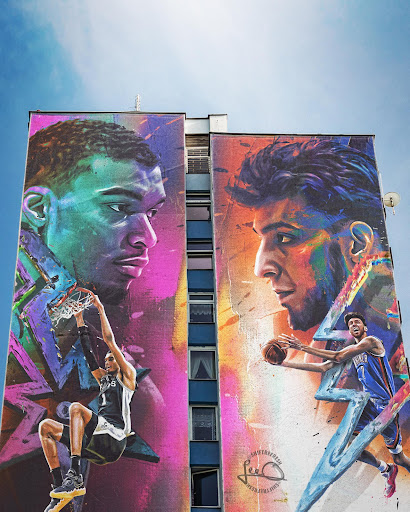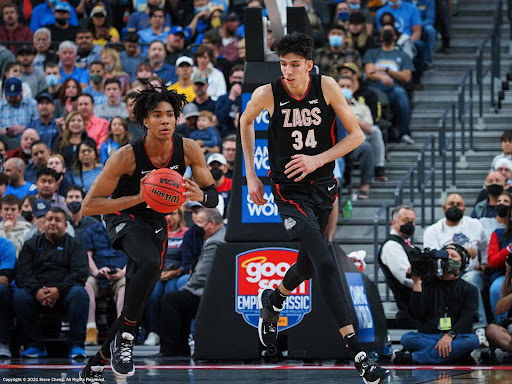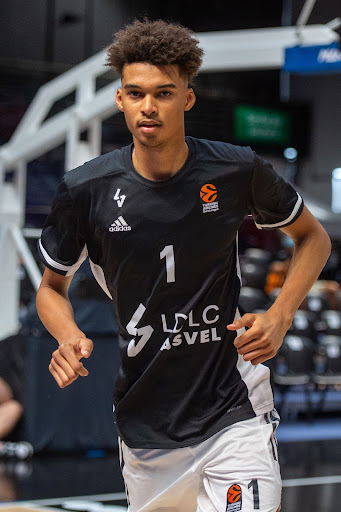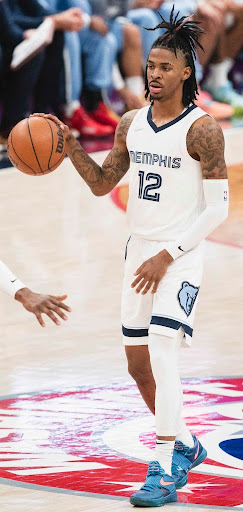
The NBA is currently in an exciting phase with the introduction of the in-season tournament injecting excitement amongst fans and fierce competition amongst players. This tournament has revitalized the regular season by offering a taste of playoff intensity much earlier in the year. Amidst this atmosphere, the spotlight is shining brightly on two incredible rookies: Victor Wembanyama of the San Antonio Spurs and Chet Holmgren of the Oklahoma City Thunder.
The emergence of Wembanyama and Holmgren is not only exciting, but it is also indicative of a significant shift in the dynamics of the league. The NBA is gradually becoming a young man’s league, as nineteen and twenty-year-olds are being handed keys to the franchise. According to The Hoops Geek, the average age has been steadily dropping from around 28.1 in 2000 to 26.1 in 2022. The days when experienced veterans held that power and guided their teams with years of experience are slowly fading away.

(Steve Cheng)
Today, Wembanyama and Holmgren mark a pivotal transition in the league’s approach to talent and leadership. This shift raises a fundamental question: Why are NBA teams prioritizing younger players over proven and experienced veterans?
The shift may be attributed to the evolving landscape of its audience. To remain relevant and engaging, the NBA needs to resonate with a younger fanbase: a recent survey from The Athletic shows that nearly 42.8% of fans are under 35 years old. Players like Wembanyama and Holmgren aren’t just exceptionally talented, but they also serve as role models for this new, upcoming generation.
Of course, this does not apply on a physical level: Wembanyama is nearly 7’4’’ while Holmgren is 7’1’’. They are literally referred to as “unicorns” in the NBA because of how rare it is to find players of this archetype. Despite their physical anomalies, they share generational values and experiences with younger fans, which makes them not just players on the court but icons of this new era.

It is important to realize that generational stars only come around approximately once every two decades. Kareem Abdul-Jabbar, a 6-time MVP and 6-time NBA champion, was drafted in 1969. Michael Jordan, a 5-time MVP, Defensive Player of the Year, and 6-time NBA Champion, was drafted in 1984. Lebron James, a 4-time MVP and 4-time NBA Champion, was drafted in 2003. Chet Holmgren and Victor Wembanyama were drafted in 2022 and 2023 respectively.
The emergence of generational stars is also important because its timing seemingly coincides with the arrival of a new generation of fans. This means that every cohort of young fans can grow up with iconic figures they can admire, which is critical for the NBA’s long-term engagement and growth. Holmgren and Wembanyama not only keep the league exciting, but they also renew fan interest to ensure the league’s overall success and relevance for the coming years.
These players are more than just valuable assets to their team; they may also be a goldmine for the league as a whole. They have the potential to become the face of the NBA both on and off the court, and their marketability can bring a new era of prosperity and appeal. As the NBA prepares for this upcoming generation of players, it signals a significant shift in the league’s dynamics. This transition, however, does not come without its challenges, particularly in the form of the maturity of these younger players. The recent incident of Ja Morant shows the importance of balancing youth and the responsibility that comes with being in the public eye.
At just 24 years old, Ja Morant has rapidly ascended as the superstar of the Memphis Grizzlies, captivating fans with his electrifying dunks and clutch plays that left opponents in utter shock. His dynamic presence on the court even drew comparisons to Derrick Rose’s historic MVP season, and it solidified him as one of the best players in the entire NBA.

However, Morant brandished a gun in March 2023 and received an 8-game suspension. Then he did it again in May 2023 and is currently suspended for the first 25 games of the 2023-2024 season. Morant’s reckless actions significantly damaged his reputation, particularly amongst his 10 million Instagram followers. His off-court drama casts a large shadow over his public image, disappointing fans who not only admired his on-court brilliance but even looked up to him as a role model.
In the age of social media, players need to be extremely careful with their actions. Fans can develop strong, personal connections with athletes, and these connections are heavily influenced by how the players conduct themselves both on and off the court. Morant’s actions serve as a reminder of this new reality in the digital age, where athletes are also influencers whose actions can profoundly impact their followers.
Moreover, Morant’s suspension has severely impacted his team: the Grizzlies were the number 2 seed with Morant last season, but they are significantly worse this season because of injuries and Morant’s absence, instead landing the 13th seed in the Western Conference. Fans are also robbed of witnessing remarkable talent on the court for a significant portion of the season. His absence reminds us how off-court actions have far-reaching implications, as they do not just affect the individual player but the entire narrative of the league.
While these young players bring new energy and incredible skill, they must also navigate the challenges of fame and expectations at such a young age. The NBA is waiting for that perfect blend of talent, charisma, and personal conduct that can define the era. The expectations for Wembanyama and Holmgren are extremely high, but the hope is that they will embody the values and responsibilities of being role models to this upcoming generation.
